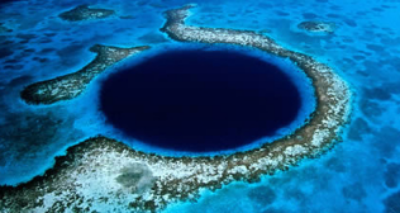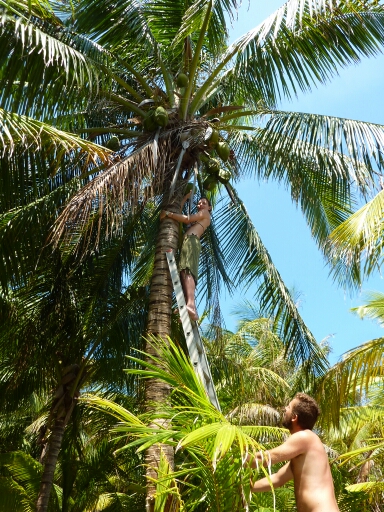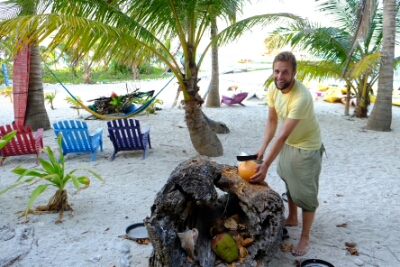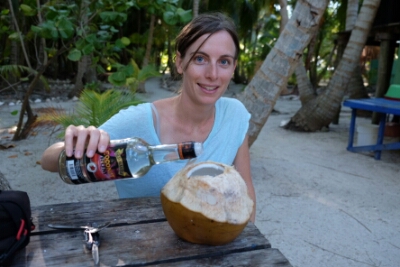Blog Archives
Guatemala II – Welcome to the Jungle
We came to Petén, the northern most department of Guatemala, sharing borders with Mexico and Belize, to explore the Jungle and some of the more important Mayan ruins.
Tikal was in its heyday around 200 to 900 AD, the city was one of the largest in Mesoamerica and dominated much of the Mayan region. Due to a supposed combination of aggressive farming techniques (log a forest, burn, plant crops, harvest and repeat – not so sustainable with only a shallow layer of topsoil), overpopulation and maybe a meteorological drought Tikal was eventually abandoned and left for the forest to reclaim.
These days, apart from being an important historical site, it was made famous by George Lucas in the Star Wars episode IV movie.
Tikal is one of the most touristy Mayan sites around, however, for good reason. You walk through dense jungle paths spotting wildlife like venado (a type of deer), coatimundi and spider monkeys, and then come upon clearings with pyramids and temples that tower above the jungle.
The Maya temples and pyramids are said to have been constructed using always steps in multiples of 13, because they believed in 13 levels of heaven. They also believed in 9 levels of the inframundo (underworld) which were connected with heaven by the sacred Ceiba Tree which is now Guatemala’s national tree.
Quite the developed mathematicians, the Mayans used a vigesimal numeral system which uses 20 (count all fingers & toes) as a base instead of 10 as in the decimal system we use. This combined with the number 13 also links back to the Mayan calendar that we mentioned in the last post…interesting but very confusing!
After Tikal and some excellent reports from fellow travellers (thanks Mike & Ana!), we signed up to a 60km trek in the jungle over 5 days to see a much less visited site, El Mirador, just 6kms from the Mexican border. It predates Tikal, with occupation recorded between 900BC and 150AD and is the site of the tallest pyramid in Mayan history. We started off with a 4hr chicken bus ride from Flores to Carmelita, the village closest to the ruins. It was the first of many fun chicken bus journeys on this trip, complete with cramped seats made for Mayan sized legs, lots of stops, a bumpy, potholed dirt road and beautiful scenery!
Carmelita is a small village, in the national park, that subsists mainly thanks to the tourism & logging contracts. There is a co-operative of guides, cooks, arrieros (mule handlers) who lead treks out to see the ruin sites and ensure the tourism $ is shared across the families of the cooperative and community. The government have plans to build a train out to El Mirador, which is of great concern to the co-op members. The last time the government tried to push the plans, the locals threatened to burn the jungle down – a scary thought!
The trek was a great way to get a bit off the well beaten tourist trail and see a site in a state more similar to how it was when re-discovered in the 20th century. Walking through the jungle, we saw howler and spider monkeys, toucans, pisotes, coches (wild pigs), wild turkeys, moths & butterflies, snakes, a scorpion and lots of small mounds which were Mayan burial tombs retaken by the jungle.

Sadly all the tombs have trenches dug into them by local tomb raiders who stole the jade, obsidian and other articles of value.
We also learnt loads about about the local flora which included Chicle trees (whose sap is boiled to make the base of chewing gum), Oak trees, Copal tree (its sap is burnt for incense in religious ceremonies) and Ramon trees whose nutricious seeds are used in smoothies and made into cookies, ice-cream etc and its leaves which were the mules favourite food. We also ate Sapodilla fruit found along the way and prepared a tea from the allspice plant (apparently good for the upset stomach!).
Each night we got used to quick pond water bucket showers, and climbing pyramids to get views the jungle and sunsets. In the mornings, Howler monkeys took the place of kookaburras as alarm clocks, with a scary cry/cough starting around 4am that sounded a bit like something from Jurassic Park!!

A recent exploratory dig at El Tintal, showing evidence of la calzada Maya, the ancient Mayan causeway that connected cities.
The American archaeologist Richard Hansen, leads the excavation project at the El Mirador site, but due to the logistical difficulties of the area, they are only working at the site during the wet season, July-Sept, when there is enough water for the 300+ workers.
Only approximately 25% of El Mirador has been uncovered so it required a fair amount of imagination, however it was really cool to see the dig in progress. In another 10 years or so it will probably be the next Tikal or Machu Picchu (specially if the train goes ahead!).

Interesting parts of the ruins are mid-excavation, with black tarps or full-on roof structures to cover depending on the time of discovery & importance.
Highlights were La Muerta, a multi-layered temple used as tomb, el Tigre complex for monkey and toucan spotting and La Danta, the tallest Pyramid ever constructed by the Mayans at 72m high.

The crew on top of La Danta!! Mel Gibson filmed parts of his movie Apocalyto here in 2005/6. He’s now a main sponsor of the ruins to try and make up for making apparent stuff ups in his representations of the Maya people.
Next up, there’s plenty more action to come from Guatemala as we start heading south.
Guatemala I – Livingston to Flores
The 45min boat ride from Punta Gorda (Belize) to Livingston (Guatemala) has been the most interesting border crossing so far. The tiny boat – called tiburoneta – was carrying 4 tourists, a local lady who gave us plenty of information, and a case of whisky that our skipper bought at the duty free. Who or what would have been saved in case of an emergency we’ll leave for you to imagine.

The blue stripes represent the Pacific and Atlantic Oceans. The motto reads “Libertad 15 Septiembre de 1821”, which is when Guatemala became independent from Spain, and the Quetzal is the national bird.
After all, the ride was quite pleasant and we set foot in steaming hot Livingston in late April. Livingston is located on the Caribbean coast of Guatemala and it can only be reached by boat.
We spent the rest of the day walking around town, trying the local dishes (keep an eye for our gastronomy section coming up soon!) and watching the locals socialising and playing sports at night time (too hot otherwise).

We thought that Belize couldn’t get more multicultural and that we would understand everything that the Chapines (people from Guatemala) would say… but we couldn’t have been further from the truth. Guatemala is home to the 3rd largest indigenous community in the world (behind Mexico and Bolivia, with more than 1/3 of its 14 million population) and around 20+ different languages spoken, Spanish being the second language.
As far as safety is concerned, the different gangs of ‘Los Maras‘ were our main concern. However, they’re mainly based in the city and don’t tend to come out anymore as the people are quite violent towards them.
7 Altares is a nice excursion from Livingston. After a nice walk crossing a maya settlement and a rainforest you get to the natural pools that helped us to cool down. It was a shame that the rainy season hadn’t started yet so the waterfalls were a bit dry (we were only 8 hours early but of course no one knew that!).

The big thunderstorm and blackout met us as we were transferring photos to dropbox… but despite the annoyance, the rain was really welcome as we were able to sleep fresh.
The next day we took another tiburonera into Río Dulce (the only way to get to the rest of Guatemala) and we spent a couple of days in a hostel by the river.

Rio Dulce is supposed to be the best spot for boats to hide from the hurricaines that hit Central America
Our English&Dutch hosts told us a lot of interesting stories about the river, being the highway for narcos to transport drugs up north. In fact, they claimed that 95% of the cocaine that is later sold in the States has passed up the river.
Far from stressing them, they’re actually quite ‘thankful’ to the narcos as they keep the area safe and out of the TV news, which at the end brings them more tourists and less attention from the police! As you can imagine, keeping the area clean requires some bad-asses to do the job… Once every four years or so they run a cleaning spree…the last ended up with over 160 dead. Among them, robbers, criminals, rapists and assassins. We felt really safe at all times and it was really interesting to understand the different perspectives about drug traffickers of the people who actually live there.
Staying by the river was a great experience and we had plenty to do, from going kayaking…

… to exploring the local communities living by the river, swimming in natural hot springs, caving, clearing our pores in a natural sauna or swimming in phosphorescence at night. Every stroke filled the water with magic sparkles!

The only thing we missed was spotting the manatees… but the early morning was beautiful as the fog invaded the river and the birds awoke.

Another boat ride finally set us on Guatemala mainland, in a tiny town consisting of a busy street packed with market stalls and chicken buses connecting the river to the other spots in the country.
Most of the tourists go straight to the Tikal ruins, but we decided to spend a couple of days in a Finca, half-way to the ruins. The little stopover was well worth it as we were able to meet some great people there: Adri & Lani, 2 volunteers working in the finca in exchange for accommodation and meals, and Ana & Mike, a Spanish-Irish couple that we’ve been sharing our journey with over the last week.
The finca also employs lots of locals in all sorts of activities, from farming, guiding tours and running the comedor. We were lucky enough to join Adri & Lani, Harry, Edgarcito (a straight mulleted 9 year old who wants to become a guide and would be quite suited to it since he never shut up) and Fifi…who would you believe was a great dane, on a walk to the caves in the farm.
The finca also runs a nice bar at night where we had the chance to meet some locals and some American soldiers from the special forces who were working in a base nearby. Funnily enough, when asked about what sort of work they were doing there, they got a bit awkward and gave different versions each time..
After sharing lots of travelling tips with our new friends, playing lots of card games (rainy season means quiet afternoons and finally, using blankets), ping pong and some blogging, we caught the next shuttle to Flores.
Flores is the base for visiting the Tikal ruins (coming in the next post), but also a tourist trap type town disguised with pretty buildings and clean streets…some of them flooding…
The nice thing is that Flores is surrounded by a lake and we were spoilt with some beautiful sunsets before exploring the ruins.

This is a summary of our quiet first week in Guatemala, stay tuned for 3 action-packed weeks coming soon!
Hugs,
Sal & Xavi
Belize Part II – The Mainland
In between our trips to Belize’s Cayes, we have also seen a bit of the interior of the country which has a very different vibe and culture.
After Caye Caulker we ventured out to Orange Walk to visit the Lamanai Mayan ruins. The town is home to Belize’s biggest rum distillery (the local Alcoholic Anonymous group certainly wasn’t as full as it should have been!) and some excellent street food influenced by its proximity to Mexico!
It’s an amazing multicultural place, where you see Belizeans, Mayan, Chinese, Hindus and Mennonites all in a short walk around town where you can hear people speaking Creole, English, Chinese, German or Spanish as a first language depending on their background.
The Mennonites, the most recent group to migrate there, have been a welcome addition to the under-populated country, bringing farming and woodworking expertise (although they are also blamed for clearing forest for farm land). They are a religious people originating from Germany who create their own sustainable communities and most of them do not use technology. After migrating through various different countries (Canada, Mexico, etc) who didn’t fully accept their way of living, they have settled in Belize because the country allows them to exist outside the taxation system as they claim that they don’t benefit from the welfare. It’s easy to recognise them, men wear overalls, blue shirts and farmer hats while women stick to ankle length dresses.
From Orange Walk we visited the Lamanai ruins, which are reached by boat, after cruising through a complex series of tight and not so tight river bends, slowing only to pass local fishermen and spot wildlife, before arriving at the destination on the side of a large freshwater lake.
The temples in Lamanai are largely unexcavated, so are partially covered in jungle. We walked between temples along jungle paths with howler monkeys and even saw a snake and a toucan! The guides taught us the howler monkey call which has since proven handy in our more recent jungle expeditions (more on that in a later post).
The temples are thought to be solid structures used for religious ceremonies (temples with crest) and astronomy (flat roofed pyramids).
Contrary to popular belief, there is very little evidence to suggest that Mayans performed human sacrifices (except after ball games and if they discovered people counterfeiting the cacao bean currency with balls of dirt – there are a lot of conflicting stories around).
This is especially true in Lamanai as the abundance of water left the people no need to try and appease the rain god.
Before crossing the border to Guatemala, we visited the biggest concentration of Mayan people in Belize, who live in the Toledo Region in the South. To get there, we left the local bus heading South towards Punta Gorda at the turnoff to San Felipe and started to walk along the dirt road hoping to get a ride along the way. Our hitch hiking technique is a bit of a competition and involves us taking turns to stick out the thumb. After a few failed attempts, Xavi managed to hail us a ride ( Xavi 1 – Sal 0) holding onto the back of a red 4WD (that was already full inside) to San Felipe, our cacao farm destination.
After probably the best chicken, rice and beans of the trip so far (and yes there have been many!) which was all made with ingredients from the farm, we started our lesson in chocolate making and Maya culture.
The process of making chocolate while involving many steps is actually amazingly simple. Starting with picking the cacao pod from the tree, the beans inside are selected and, after separating them from the fruit around them, roasted, peeled, then crushed by hand using special stone tools.
From there we added the desired quantity of sugar for an 80% cacao recipe, crushed/mixed again before dropping into molds for refrigeration and voila! We were so busy enjoying the end product that we forgot to take pictures!
Apart from making chocolate, our host Juan also explained a few interesting details about Mayan history including the end of the Mayan calendar in Dec 2012. Basically the whole apocalypse scenario was all drummed up by Hollywood and foreigners. In reality, the ending of the ancient Mayan calendar signified the end of an era calculated mathematically and linked with the astrological cycles of the sun and constellations. Nevertheless, business owners in all Central America were really happy with the boost in tourism!
We visited another few villages in the area the following day with an ambitious plan to hitchhike to a local waterfall. It didn’t go quite to plan when after walking 45 mins on a really hot day along a road with no shade we still hadn’t had any success – at this stage I was having serious second thoughts about not having waited a few hours for the direct bus! But to Xavi’s surprise, he managed to get us another free ride with a local school teacher on long service leave (Xavi 2 – Sal 0).
To conclude our Belize chapter, we continued south to Punta Gorda, another seaside village, and caught a small boat over to Livingston in Guatemala. More adventures to come from there soon!
Lots of love,
Xavi & Sal
Belize Part I – The Barrier Reef
Belize, a multi-cultural country the size of Jamaica and only 325,000 inhabitants, is home to the second largest barrier reef in the world and was a must-go destination for us because we love diving! 
We left you with the 6hr overnight bus ride from Tulum. Once in Belize City, a pretty dodgy place (4 people were murdered there over Easter holidays), we went straight from the bus station to the docks with other travellers. There we took the 45min water taxi to Caye Caulker, a backpacker-friendly, caribbean style piece of paradise where push bikes and golf carts are the preferred ways to get around. 
Caye Caulker’s place to be is ‘the split’, a channel of water with a strong current created by Hurricane Hattie in the early sixties, that cut the caye in two. Nowadays, tourists and locals party, launch themselves into the channel, drink and dance to reggae and disco hits at The Lazy Lizard in this spot, which is also a prime location for sunset viewing.  
Sal and I got into the island mood, where everything goes quite slowly with ease… but after a couple of days of lazing around, we had an early 4.45am start to gear up for the famous Great Blue Hole dive. Located at the Lighthouse Reef, around 2 hours south-east of Caye Caulker, the Great Blue Hole is a 124 metre deep cave that collapsed 153,000 years ago!
It became really popular thanks to Jacques Cousteau, who declared it one of the top10 dives in the world.  And he was right.. after an easy 15m descent to the sandy floor of the reef, you face a 300 metre in diameter hole that drops into an abyss of darkness. I felt like we were Sandra Bullock and George Clooney in Gravity, so when we started the descent into the deep blue, I almost shat in my wetsuit! Once I got myself together, we cruised down to the depth limit for leisure diving (40m), where the hole opens up, and navigated in and around out-of-this-world stalactites under the watchful eyes of a few curious 3 metre reef sharks. All of our pictures turned out too dark, you need pretty good equipment down there.
The bottom time is short (8min), but the images will remain in our minds forever. Climbing the hole up to shallower and brighter depths felt like going back to reality. Overall, a great experience, topped off with 2 more dives where we saw plenty of tropical fish and turtles.
We had another bit of excitement on a canoe trip to explore the part of the island north of the split. After paddling a few hours against the current & wind crossing the channel to get back (not our cleverest idea to go with the wind first), we were ‘rescued’ by an American couple in their dinghy saving us a lot more hard paddling! Back at the caye, we ended our 3 day stay watching an American rap video clip being filmed (hilarious), learning new card games and meeting other backpackers at the hostel. 
Once returned to the mainland and after a week of exploring, we had crossed most of Belize’s coast and we were ready for our 2nd seaward expedition, to Glover’s Reef. Glover’s Reef is a partially submerged atoll 45km off the mainland. We stayed on North-East Caye, which barely takes 5min to walk around. On the way there we met a great bunch of fellow travellers, Anton & Lilly, Sylvan & Chantal, Romain and Nathalie to share the sunsets, drinks, activities and meals with, thanks guys! 
While the pictures may look as if we stayed in a fancy resort, the truth is that it’s pretty affordable and there are different accommodation options, from camping in your own tent, a dorm, beach cabins, up to nice cabins over the water. Sal and I enjoyed a dorm to ourselves (no farting teenagers this time, Furo). The rest of facilities were pretty basic (compost toilets, bore water showers, no electricity,…) so it felt a bit like our own Robinson Crusoe / LOST adventure. 
The stay was really cool, a real slice of paradise! To begin with, all the coconuts you can find/open/eat/drink are free. Sal turned into the Scrat (the squirrel from Ice Age) in coconut heaven and started trying to climb trees and stockpile coconut after coconut.
Then we were trained in the opening techniques, either the machetes for the drinking ones (green and yellow on the outside, still hanging from the trees – great with coconut rum!)….  
…or the “peeling stick” & machete combination for the eating ones (already brown and fallen from the trees). Happy to say we still have all our fingers intact!   
After lots of reading, lying on hammocks and peeling coconuts, we went for a couple of dives, but snorkelling was so good that we stuck to free diving after that. Tropical fish, beautiful coral, nurse sharks, eagle rays, lobsters… you name it, we were spoiled for choice.      
Spear-fishing is very popular too. In fact, you could buy fresh fish almost every night from the locals that run the resort. Luckily for us we met an American guy who was happy to swap a couple of freshly caught red snapper for coco-locos…
we couldn’t believe our luck, as his experienced local guide deboned and scaled the fish on the jetty for us.
We prepared them 2 ways: in a Jamaican curry sauce with coconut milk and coconut rice and just grilled over coals.  The 2 snapper fed our group of 8 and we still had leftovers for the next day, definitely the best meal of the trip so far! 
This has been a long post, so we will cover Belize by land in the next update! Thanks for following us! 




























































































